Rapid Plasma Synthesis of Gold Nanoparticles Supported on MWCNTs for Electrochemical Detection of Glucose
Abstract
1. Introduction
2. Experimental Section
2.1. Materials
2.2. Catalyst Preparation
2.2.1. Preparation of AuNPs-P-MWCNTs
2.2.2. Preparation of AuNPs-C-MWCNTs
2.2.3. Preparation of Electrodes
2.3. Catalyst Characterization and Electrochemical Testing
3. Results and Discussion
3.1. Electrochemical Properties
3.2. Structure and Morphology of Nanocomposites
3.3. Discussion
4. Conclusions
Supplementary Materials
Author Contributions
Funding
Institutional Review Board Statement
Informed Consent Statement
Data Availability Statement
Conflicts of Interest
References
- Yang, X.; Wu, F.; Huang, H.; Zheng, G.; Zhang, H.; Cai, W.; Li, J.; Yin, Z.-Z.; Kong, Y. Au nanoparticles anchored carbonized ZIF-8 for enabling real-time and noninvasive glucose monitoring in sweat. Biosens. Bioelectron. 2025, 272, 117138. [Google Scholar] [CrossRef] [PubMed]
- Zhang, Y.; Zeng, X.; Liu, Y.; Wang, C.; Jin, C.; Hou, J.; Yang, M.; Huo, D. Pt single-atom catalyst on Co3O4 for the electrocatalytic detection of glucose. ACS Appl. Nano Mater. 2024, 7, 13693–13700. [Google Scholar] [CrossRef]
- Zhang, R.X.; Yang, P.; Zhang, Y.X. A novel high-sensitivity non-enzymatic glucose sensor via Cu2O@CuO@NiCo2O4 nanowires as catalyst. Mater. Lett. 2020, 272, 127850. [Google Scholar] [CrossRef]
- Peng, Q.; Zhang, Y.; Yang, S.; Yuwen, T.; Liu, Y.; Fan, J.; Zang, G. Glucose determination behaviour of gold microspheres-electrodeposited carbon cloth flexible electrodes in neutral media. Anal. Chim. Acta 2021, 1159, 338442. [Google Scholar] [CrossRef]
- Zhong, X.; He, Z.; Chen, H.; Chen, Y. Enhancing the non-enzymatic glucose detection performance of Ni(OH)2 nanosheets via defect engineering. Surf. Interfaces 2021, 25, 101234. [Google Scholar] [CrossRef]
- Hao, Y.; Fang, M.; Xu, C.; Ying, Z.; Wang, H.; Zhang, R.; Cheng, H.-M.; Zeng, Y. A graphene-laminated electrode with high glucose oxidase loading for highly-sensitive glucose detection. J. Mater. Sci. Technol. 2021, 66, 57–63. [Google Scholar] [CrossRef]
- Dong, P.; Singh, K.A.; Soltes, A.M.; Ko, B.S.; Gaharwar, A.K.; McShane, M.J.; Grunlan, M.A. Silicone-containing thermoresponsive membranes to form an optical glucose biosensor. J. Mater. Chem. B 2022, 10, 6118–6132. [Google Scholar] [CrossRef]
- Cao, L.; Wang, P.; Chen, L.; Wu, Y.; Di, J. A photoelectrochemical glucose sensor based on gold nanoparticles as a mimic enzyme of glucose oxidase. RSC Adv. 2019, 9, 15307–15313. [Google Scholar] [CrossRef]
- Azkune, M.; Frosch, T.; Arrospide, E.; Aldabaldetreku, G.; Bikandi, I.; Zubia, J.; Popp, J.; Frosch, T. Liquid-core microstructured polymer optical fiber as fiber-enhanced raman spectroscopy probe for glucose sensing. J. Light. Technol. 2019, 37, 2981–2988. [Google Scholar] [CrossRef]
- Hu, Y.; Cheng, H.; Zhao, X.; Wu, J.; Muhammad, F.; Lin, S.; He, J.; Zhou, L.; Zhang, C.; Deng, Y.; et al. Surface-enhanced raman scattering active gold nanoparticles with enzyme-mimicking activities for measuring glucose and lactate in living tissues. ACS Nano 2017, 11, 5558–5566. [Google Scholar] [CrossRef]
- Toi, P.T.; Trung, T.Q.; Dang, T.M.L.; Bae, C.W.; Lee, N.-E. Highly electrocatalytic, durable, and stretchable nanohybrid fiber for on-body sweat glucose detection. ACS Appl. Mater. Interfaces 2019, 11, 10707–10717. [Google Scholar] [CrossRef] [PubMed]
- He, C.; Asif, M.; Liu, Q.; Xiao, F.; Liu, H.; Xia, B.Y. Noble metal construction for electrochemical nonenzymatic glucose detection. Adv. Mater. Technol. 2022, 8, 2200272. [Google Scholar] [CrossRef]
- Zhang, L.; Ye, C.; Li, X.; Ding, Y.; Liang, H.; Zhao, G.; Wang, Y. A CuNi/C nanosheet array based on a metal–organic framework derivate as a supersensitive non-enzymatic glucose sensor. Nano-Micro Lett. 2017, 10, 28. [Google Scholar] [CrossRef]
- Bi, R.; Ma, X.; Ma, P.; Wang, Q. Defect-rich cypress-leaf-like Cu2+1O@NiF for high-performance non-invasive glucose detection with low detection limit. Colloids Surf. A Physicochem. Eng. Asp. 2024, 698, 134509. [Google Scholar] [CrossRef]
- Zhong, S.-L.; Zhuang, J.; Yang, D.-P.; Tang, D. Eggshell membrane-templated synthesis of 3D hierarchical porous Au networks for electrochemical nonenzymatic glucose sensor. Biosens. Bioelectron. 2017, 96, 26–32. [Google Scholar] [CrossRef]
- Mei, H.; Wang, X.; Zeng, T.; Huang, L.; Wang, Q.; Ru, D.; Huang, T.; Tian, F.; Wu, H.; Gao, J. A nanocomposite consisting of gold nanobipyramids and multiwalled carbon nanotubes for amperometric nonenzymatic sensing of glucose and hydrogen peroxide. Microchim. Acta 2019, 186, 235. [Google Scholar] [CrossRef]
- Kangkamano, T.; Numnuam, A.; Limbut, W.; Kanatharana, P.; Thavarungkul, P. Chitosan cryogel with embedded gold nanoparticles decorated multiwalled carbon nanotubes modified electrode for highly sensitive flow based non-enzymatic glucose sensor. Sens. Actuators B Chem. 2017, 246, 854–863. [Google Scholar] [CrossRef]
- Wittstock, A.; Zielasek, V.; Biener, J.; Friend, C.M.; Baeumer, M. Nanoporous gold catalysts for selective gas-phase oxidative coupling of methanol at low temperature. Science 2010, 327, 319–322. [Google Scholar] [CrossRef]
- Wei, M.; Qiao, Y.; Zhao, H.; Liang, J.; Li, T.; Luo, Y.; Lu, S.; Shi, X.; Lu, W.; Sun, X. Electrochemical non-enzymatic glucose sensors: Recent progress and perspectives. Chem. Commun. 2020, 56, 14553–14569. [Google Scholar] [CrossRef]
- Branagan, D.; Breslin, C.B. Electrochemical detection of glucose at physiological pH using gold nanoparticles deposited on carbon nanotubes. Sens. Actuators B Chem. 2019, 282, 490–499. [Google Scholar] [CrossRef]
- Caetano, F.R.; Felippe, L.B.; Zarbin, A.J.G.; Bergamini, M.F.; Marcolino-Junior, L.H. Gold nanoparticles supported on multi-walled carbon nanotubes produced by biphasic modified method and dopamine sensing application. Sens. Actuators B Chem 2017, 243, 43–50. [Google Scholar] [CrossRef]
- Chen, Y.; Zhao, G.; Lin, L. Preparation and electrocatalytic properties of gold nanoparticles loaded carbon nanotubes. Chin. Chem. Lett. 2018, 29, 1633–1636. [Google Scholar] [CrossRef]
- Murugan, E.; Rubavathy Jaya Priya, A.; Janaki Raman, K.; Kalpana, K.; Akshata, C.R.; Santhosh Kumar, S.; Govindaraju, S. Multiwalled carbon nanotubes/gold nanoparticles hybrid electrodes for enzyme-free electrochemical glucose sensor. J. Nanosci. Nanotechnol. 2019, 19, 7596–7604. [Google Scholar] [CrossRef] [PubMed]
- Seitkalieva, M.M.; Samoylenko, D.E.; Lotsman, K.A.; Rodygin, K.S.; Ananikov, V.P. Metal nanoparticles in ionic liquids: Synthesis and catalytic applications. Coord. Chem. Rev. 2021, 445, 213982. [Google Scholar] [CrossRef]
- Britto Hurtado, R.; Cortez-Valadez, M.; Aragon-Guajardo, J.R.; Cruz-Rivera, J.J.; Martínez-Suárez, F.; Flores-Acosta, M. One-step synthesis of reduced graphene oxide/gold nanoparticles under ambient conditions. Arab. J. Chem. 2020, 13, 1633–1640. [Google Scholar] [CrossRef]
- Ovais, M.; Raza, A.; Naz, S.; Islam, N.U.; Khalil, A.T.; Ali, S.; Khan, M.A.; Shinwari, Z.K. Current state and prospects of the phytosynthesized colloidal gold nanoparticles and their applications in cancer theranostics. Appl. Microbiol. Biotechnol. 2017, 101, 3551–3565. [Google Scholar] [CrossRef]
- Zhang, T.; Ouyang, B.; Zhang, X.; Xia, G.; Wang, N.; Ou, H.; Ma, L.; Mao, P.; Ostrikov, K.; Di, L.; et al. Plasma-enabled synthesis of Pd/GO rich in oxygen-containing groups and defects for highly efficient 4-nitrophenol reduction. Appl. Surf. Sci. 2022, 597, 153727. [Google Scholar] [CrossRef]
- Du, X.; Gao, F.; Hua, Y.; Zhang, X.; Li, H.; Di, L. Green, mild, and rapid plasma synthesis of nitrogen/amino-cofunctionalized MWCNTs-supported Pd catalyst in solution for boosting formic acid dehydrogenation. Fuel 2024, 377, 132751. [Google Scholar] [CrossRef]
- Hua, Y.; Zhang, J.; Zhang, T.; Zhu, A.; Xia, G.; Zhang, X.; Di, L. Plasma synthesis of graphite oxide supported PdNi catalysts with enhanced catalytic activity and stability for 4-nitrophenol reduction. Catal. Today 2023, 418, 114069. [Google Scholar] [CrossRef]
- Zhao, Q.; Bu, D.; Li, Z.; Zhang, X.; Di, L. Cold plasma preparation of Pd/Graphene catalyst for reduction of p-nitrophenol. Nanomaterials 2021, 11, 1341. [Google Scholar] [CrossRef]
- Pang, Y.; Li, H.; Hua, Y.; Zhang, X.; Di, L. Rapid synthesis of noble metal colloids by plasma–liquid interactions. Materials 2024, 17, 987. [Google Scholar] [CrossRef] [PubMed]
- Dvorak, P.; Talaba, M.; Obrusnik, A.; Kratzer, J.; Dedina, J. Concentration of atomic hydrogen in a dielectric barrier discharge measured by two-photon absorption fluorescence. Plasma Sources Sci. Technol. 2017, 26, 085002. [Google Scholar] [CrossRef]
- Mouele, E.S.M.; Tijani, J.O.; Badmus, K.O.; Pereao, O.; Babajide, O.; Fatoba, O.O.; Zhang, C.; Shao, T.; Sosnin, E.; Tarasenko, V.; et al. A critical review on ozone and co-species, generation and reaction mechanisms in plasma induced by dielectric barrier discharge technologies for wastewater remediation. J. Environ. Chem. Eng. 2021, 9, 105758. [Google Scholar] [CrossRef]
- Vanraes, P.; Bogaerts, A. The essential role of the plasma sheath in plasma–liquid interaction and its applications—A perspective. J. Appl. Phys. 2021, 129, 220901. [Google Scholar] [CrossRef]
- Morales-Lara, F.; Abdelkader-Fernández, V.K.; Melguizo, M.; Turco, A.; Mazzotta, E.; Domingo-García, M.; López-Garzón, F.J.; Pérez-Mendoza, M. Ultra-small metal nanoparticles supported on carbon nanotubes through surface chelation and hydrogen plasma reduction for methanol electro-oxidation. J. Mater. Chem. A 2019, 7, 24502–24514. [Google Scholar] [CrossRef]
- Ramos, S.V.; Cisquini, P.; Nascimento Jr, R.C.; Franco Jr, A.R.; Vieira, E.A. Morphological changes and kinetic assessment of Cu2O powder reduction by non-thermal hydrogen plasma. J. Mater. Res. Technol.—JmrT 2021, 11, 328–341. [Google Scholar] [CrossRef]
- Sabat, K.C. Production of nickel by cold hydrogen plasma: Role of active oxygen. Plasma Chem. Plasma Process. 2022, 42, 833–853. [Google Scholar] [CrossRef]
- Sauvageau, J.F.; Turgeon, S.; Chevallier, P.; Fortin, M.A. Colloidal suspensions of platinum group metal nanoparticles (Pt, Pd, Rh) synthesized by dielectric barrier discharge plasma (DBD). Part. Part. Syst. Charact. 2018, 35, 1700365. [Google Scholar] [CrossRef]
- Bruggeman, P.J.; Kushner, M.J.; Locke, B.R.; Gardeniers, J.G.E.; Graham, W.G.; Graves, D.B.; Hofman-Caris, R.C.H.M.; Maric, D.; Reid, J.P.; Ceriani, E.; et al. Plasma–liquid interactions: A review and roadmap. Plasma Sources Sci. Technol. 2016, 25, 053002. [Google Scholar] [CrossRef]
- Chen, Q.; Li, J.; Li, Y. A review of plasma–liquid interactions for nanomaterial synthesis. J. Phys. D Appl. Phys. 2015, 48, 424005. [Google Scholar] [CrossRef]
- Tian, Y.; An, X.; Du, X.; Chang, D.; Li, H.; Hua, Y.; Zhang, X.; Zhang, J.; Di, L. Plasma-assisted controllable synthesis of α-Co(OH)2 supported on multiwalled carbon nanotubes in water without precipitant addition. J. Alloys Compd. 2025, 1010, 178005. [Google Scholar] [CrossRef]
- Bjelajac, A.; Phillipe, A.-M.; Guillot, J.; Fleming, Y.; Chemin, J.-B.; Choquet, P.; Bulou, S. Gold nanoparticles synthesis and immobilization by atmospheric pressure DBD plasma torch method. Nanoscale Adv. 2023, 5, 2573–2582. [Google Scholar] [CrossRef] [PubMed]
- Mariotti, D.; Patel, J.; Švrček, V.; Maguire, P. Plasma–liquid interactions at atmospheric pressure for nanomaterials Synthesis and surface engineering. Plasma Process. Polym. 2012, 9, 1074–1085. [Google Scholar] [CrossRef]
- Yang, B.; Yu, Y.; Qiao, J.; Yuan, L.; Hu, X. Solution plasma method direct synthesis of Au/CuO nanoparticles for glucose enzyme-free detection. J. Mater. Sci. -Mater. Electron. 2020, 31, 12983–12990. [Google Scholar] [CrossRef]
- Dykman, L.A.; Khlebtsov, N.G. Methods for chemical synthesis of colloidal gold. Russ. Chem. Rev. 2019, 88, 229–247. [Google Scholar] [CrossRef]
- Polley, D.; Patra, A.; Barman, A.; Mitra, R.K. Terahertz conductivity engineering in surface decorated carbon nanotube films by gold nanoparticles. Appl. Opt. 2017, 56, 1107–1112. [Google Scholar] [CrossRef]
- Zhao, Z.; Huang, Y.; Huang, Z.; Mei, H.; Xie, Y.; Long, D.; Zhu, F.; Gong, W. Nonenzymetic glucose sensitive device based on morchella shaped nickel-copper layered double hydroxide. Appl. Surf. Sci. 2022, 597, 153658. [Google Scholar] [CrossRef]
- Phetsang, S.; Kidkhunthod, P.; Chanlek, N.; Jakmunee, J.; Mungkornasawakul, P.; Ounnunkad, K. Copper/reduced graphene oxide film modified electrode for non-enzymatic glucose sensing application. Sci. Rep. 2021, 11, 9302. [Google Scholar] [CrossRef]
- Xu, J.; Li, F.; Wang, D.; Nawaz, M.H.; An, Q.; Han, D.; Niu, L. Co3O4 nanostructures on flexible carbon cloth for crystal plane effect of nonenzymatic electrocatalysis for glucose. Biosens. Bioelectron. 2019, 123, 25–29. [Google Scholar] [CrossRef]
- Gangwar, R.K.; Dhumale, V.A.; Date, K.S.; Alegaonkar, P.; Sharma, R.B.; Datar, S. Decoration of gold nanoparticles on thin multiwall carbon nanotubes and their use as a glucose sensor. Mater. Res. Express 2016, 3, 035008. [Google Scholar] [CrossRef]
- Chen, J.; Liu, G.; Xiao, Q.; Wang, C.; Zhou, Z.; Gu, C.; Yin, Z.-Z.; Liu, H. Glucose biosensors based on pinecone-shaped Au and Ni nanoparticle composite microelectrodes. ACS Appl. Nano Mater. 2022, 5, 13319–13331. [Google Scholar] [CrossRef]
- Meng, S.; Wu, M.; Wang, Q.; Dai, Z.; Si, W.; Huang, W.; Dong, X. Cobalt oxide nanosheets wrapped onto nickel foam for non-enzymatic detection of glucose. Nanotechnology 2016, 27, 344001. [Google Scholar] [CrossRef] [PubMed]
- Qi, C.; Zhang, C.; Yang, Z. Engineering Co3O4 with Co defects for highly sensitive nonenzymatic detection of glucose. Colloids Surf. A Physicochem. Eng. Asp. 2022, 654, 130096. [Google Scholar] [CrossRef]
- Liu, F.; Wang, P.; Zhang, Q.; Wang, Z.; Liu, Y.; Zheng, Z.; Qin, X.; Zhang, X.; Dai, Y.; Li, L.; et al. Porous Co3O4 nanosheets as a high-performance non-enzymatic sensor for glucose detection. Anal. Bioanal. Chem. 2018, 410, 7663–7670. [Google Scholar] [CrossRef]
- Olorundare, F.O.G.; Sipuka, D.S.; Sebokolodi, T.I.; Makaluza, S.; Midzi, N.; Kodama, T.; Arotiba, O.A.; Nkosi, D. An electrochemical immunosensor on a carbon nanofiber/gold nanoparticles platform for the detection of alpha-feto protein cancer biomarker. Sens. Bio-Sens. Res. 2023, 41, 100574. [Google Scholar] [CrossRef]
- Zhang, J.; Zhang, X.; Shi, C.; Xia, G.; Li, H.; Wang, P.; Di, L. Plasma synthesis of defect-rich flexible carbon cloth decorated with PtRu alloyed nanoclusters for highly efficient pH-universal electrocatalytic hydrogen evolution. Nanoscale 2022, 14, 15942–15949. [Google Scholar] [CrossRef]
- Yang, M.; Wan, Q.; Nie, X.; Luo, S.; Fu, Y.; Zeng, P.; Luo, W. Quantitative XPS characterization of “invisible gold” in Carlin-type gold ores through controlled acid erosion. J. Anal. At. Spectrom. 2021, 36, 1900–1911. [Google Scholar] [CrossRef]
- Kim, S.M.; Kim, G.S.; Lee, S.Y. Effects of PVP and KCl concentrations on the synthesis of gold nanoparticles using a solution plasma processing. Mater. Lett. 2008, 62, 4354–4356. [Google Scholar] [CrossRef]
- Chen, J.; Liu, X.; Zheng, G.; Feng, W.; Wang, P.; Gao, J.; Liu, J.; Wang, M.; Wang, Q. Detection of glucose based on noble metal nanozymes: Mechanism, activity regulation, and enantioselective recognition. Small 2022, 19, 2205924. [Google Scholar] [CrossRef]
- Bi, C.; Lv, H.-W.; Peng, H.-L.; Li, Q.-F. Development of non-enzymatic glucose electrode based on Au nanoparticles decorated single-walled carbon nanohorns. J. Mater. Sci.-Mater. Electron. 2021, 32, 12705–12715. [Google Scholar] [CrossRef]
- Chang, G.; Shu, H.; Ji, K.; Oyama, M.; Liu, X.; He, Y. Gold nanoparticles directly modified glassy carbon electrode for non-enzymatic detection of glucose. Appl. Surf. Sci. 2014, 288, 524–529. [Google Scholar] [CrossRef]
- Soomro, R.A.; Akyuz, O.P.; Ozturk, R.; Ibupoto, Z.H. Highly sensitive non-enzymatic glucose sensing using gold nanocagesas as efficient electrode material. Sens. Actuators B Chem 2016, 233, 230–236. [Google Scholar] [CrossRef]
- Li, Y.; Song, Y.-Y.; Yang, C.; Xia, X.-H. Hydrogen bubble dynamic template synthesis of porous gold for nonenzymatic electrochemical detection of glucose. Electrochem. Commun. 2007, 9, 981–988. [Google Scholar] [CrossRef]
- Wang, J.; Cao, X.; Wang, X.; Yang, S.; Wang, R. Electrochemical oxidation and determination of glucose in alkaline media based on Au (111)-like nanoparticle array on indium tin oxide electrode. Electrochim. Acta 2014, 138, 174–186. [Google Scholar] [CrossRef]
- Xu, M.; Song, Y.; Ye, Y.; Gong, C.; Shen, Y.; Wang, L.; Wang, L. A novel flexible electrochemical glucose sensor based on gold nanoparticles/polyaniline arrays/carbon cloth electrode. Sens. Actuators B Chem. 2017, 252, 1187–1193. [Google Scholar] [CrossRef]
- Ryu, J.; Kim, K.; Kim, H.-S.; Hahn, H.T.; Lashmore, D. Intense pulsed light induced platinum-gold alloy formation on carbon nanotubes for non-enzymatic glucose detection. Biosens. Bioelectron. 2010, 26, 602–607. [Google Scholar] [CrossRef]
- Escalona-Villalpando, R.A.; Gurrola, M.P.; Trejo, G.; Guerra-Balcázar, M.; Ledesma-García, J.; Arriaga, L.G. Electrodeposition of gold on oxidized and reduced graphite surfaces and its influence on glucose oxidation. J. Electroanal. Chem. 2018, 816, 92–98. [Google Scholar] [CrossRef]
- Xu, J.; Chen, T.; Qiao, X.; Sheng, Q.; Yue, T.; Zheng, J. The hybrid of gold nanoparticles and Ni(OH)2 nanosheet for non-enzymatic glucose sensing in food. Colloids Surf. A Physicochem. Eng. Asp. 2019, 561, 25–31. [Google Scholar] [CrossRef]
- Sabzehmeidani, M.M.; Kazemzad, M. Fabrication of gold nanoparticles surfactant assisted electrochemically on graphite sheet as efficient electrode for non-enzymatic electrochemical glucose sensing. Inorg. Chem. Commun. 2023, 155, 111130. [Google Scholar] [CrossRef]
- He, C.; Wang, J.; Gao, N.; He, H.; Zou, K.; Ma, M.; Zhou, Y.; Cai, Z.; Chang, G.; He, Y. A gold electrode modified with a gold-graphene oxide nanocomposite for non-enzymatic sensing of glucose at near-neutral pH values. Microchim. Acta 2019, 186, 722. [Google Scholar] [CrossRef]
- Shu, H.; Chang, G.; Su, J.; Cao, L.; Huang, Q.; Zhang, Y.; Xia, T.; He, Y. Single-step electrochemical deposition of high performance Au-graphene nanocomposites for nonenzymatic glucose sensing. Sens. Actuators B Chem. 2015, 220, 331–339. [Google Scholar] [CrossRef]

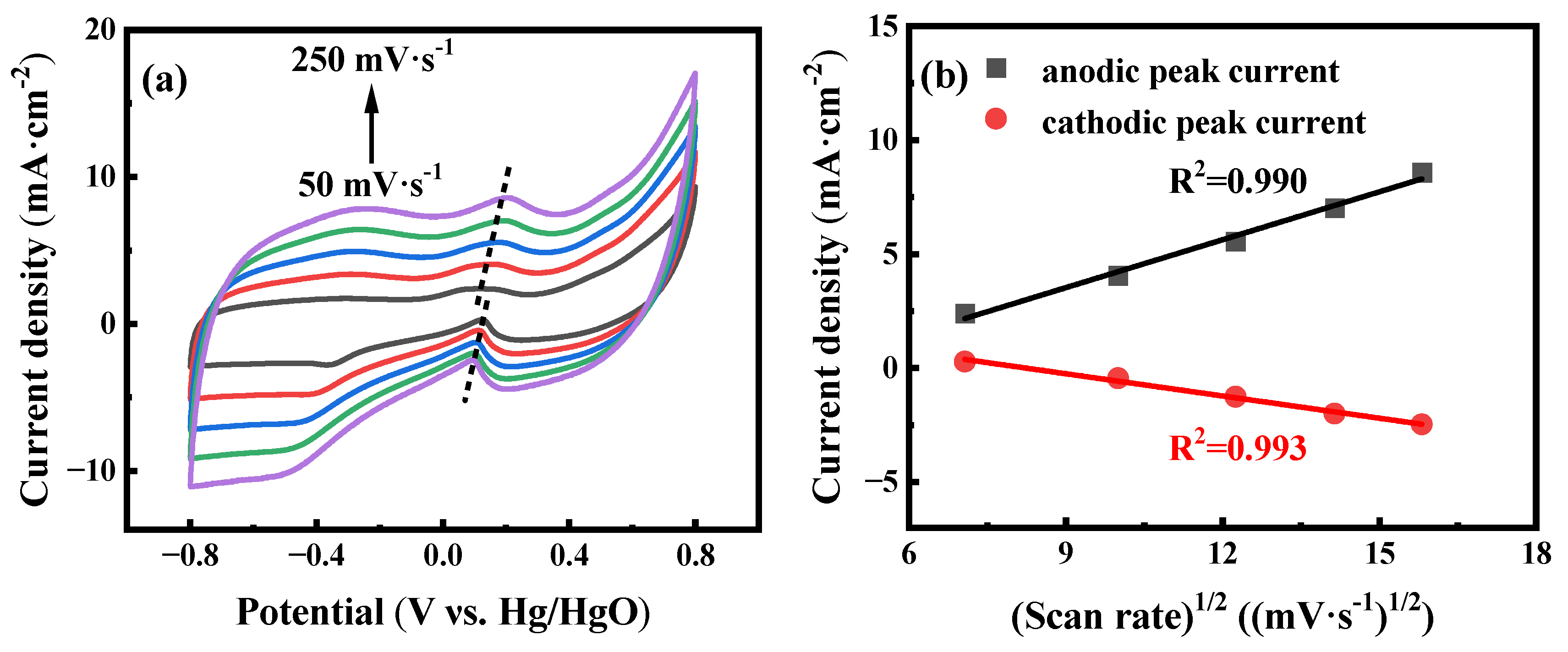
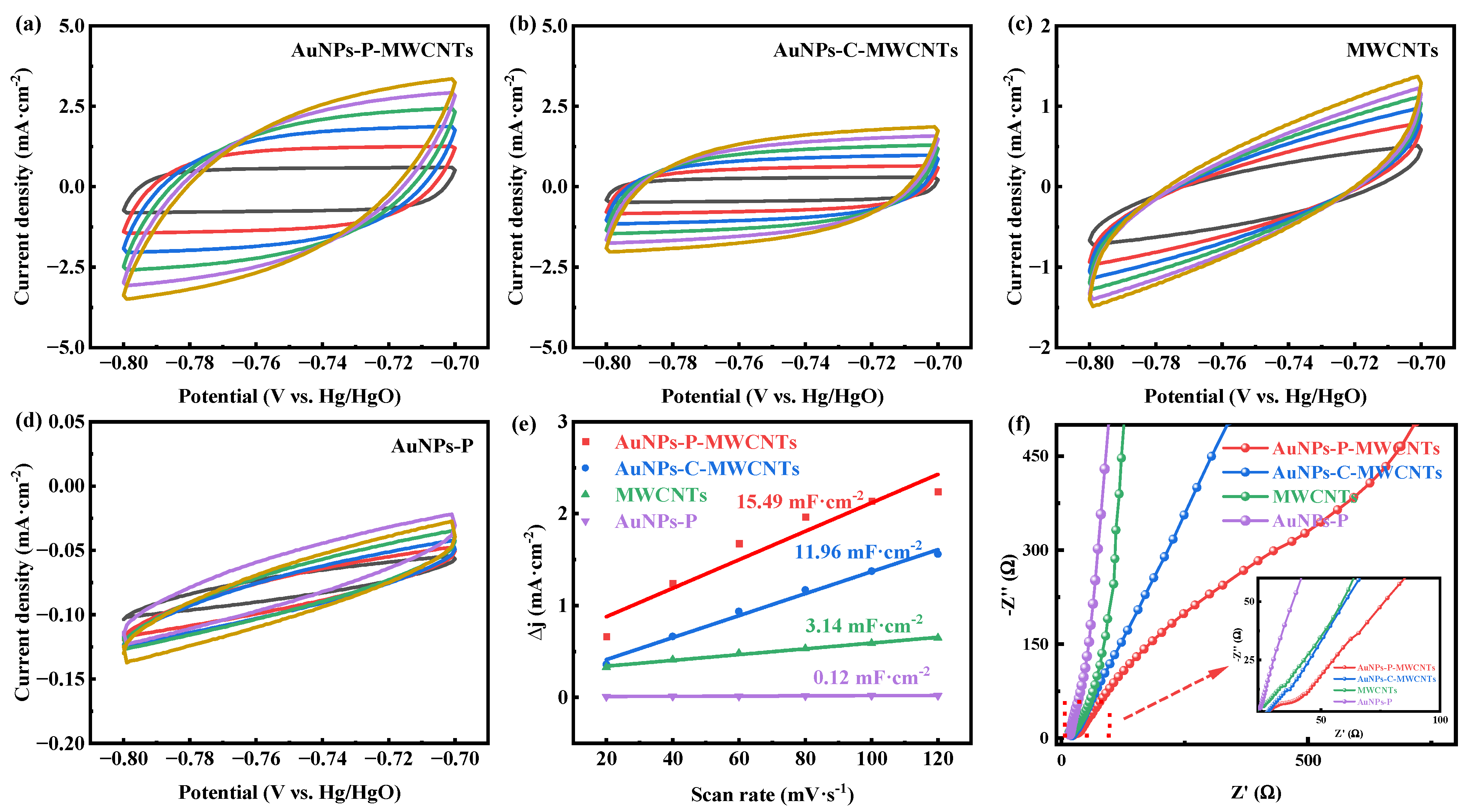
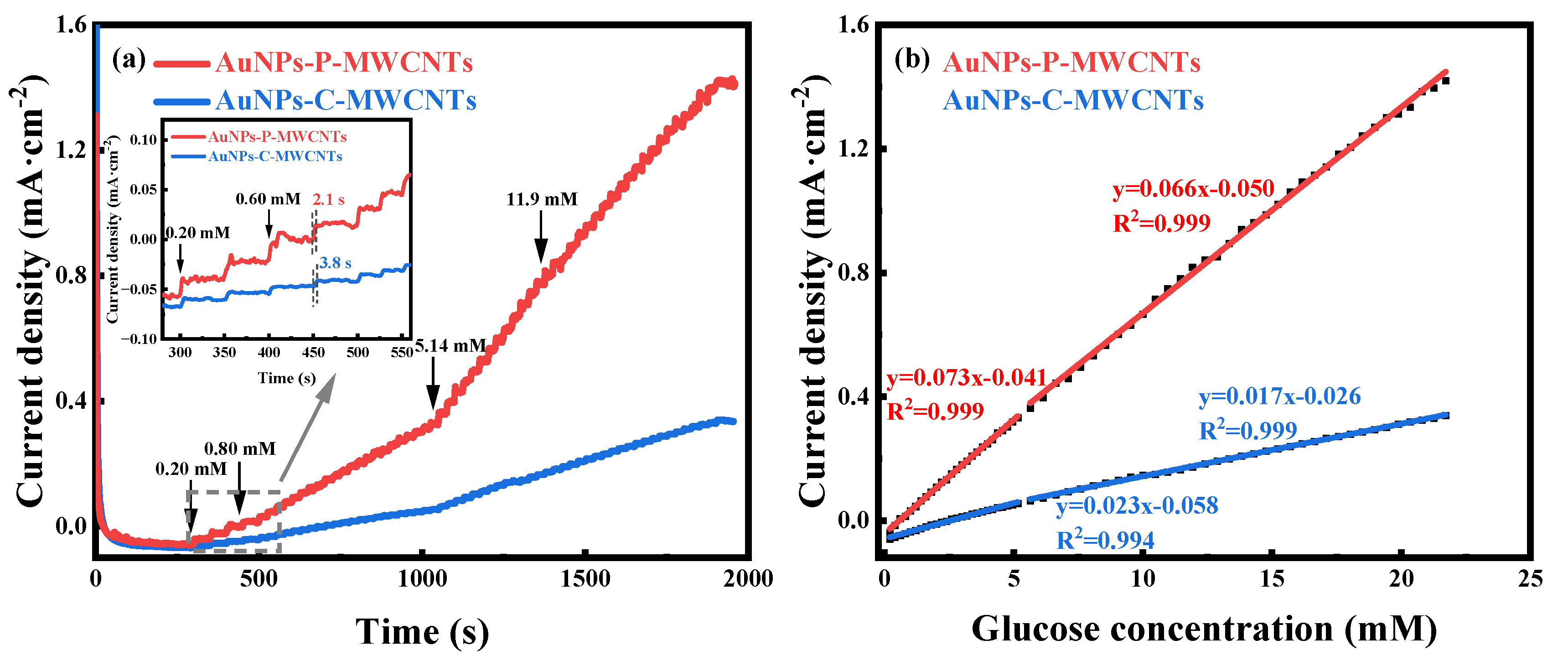
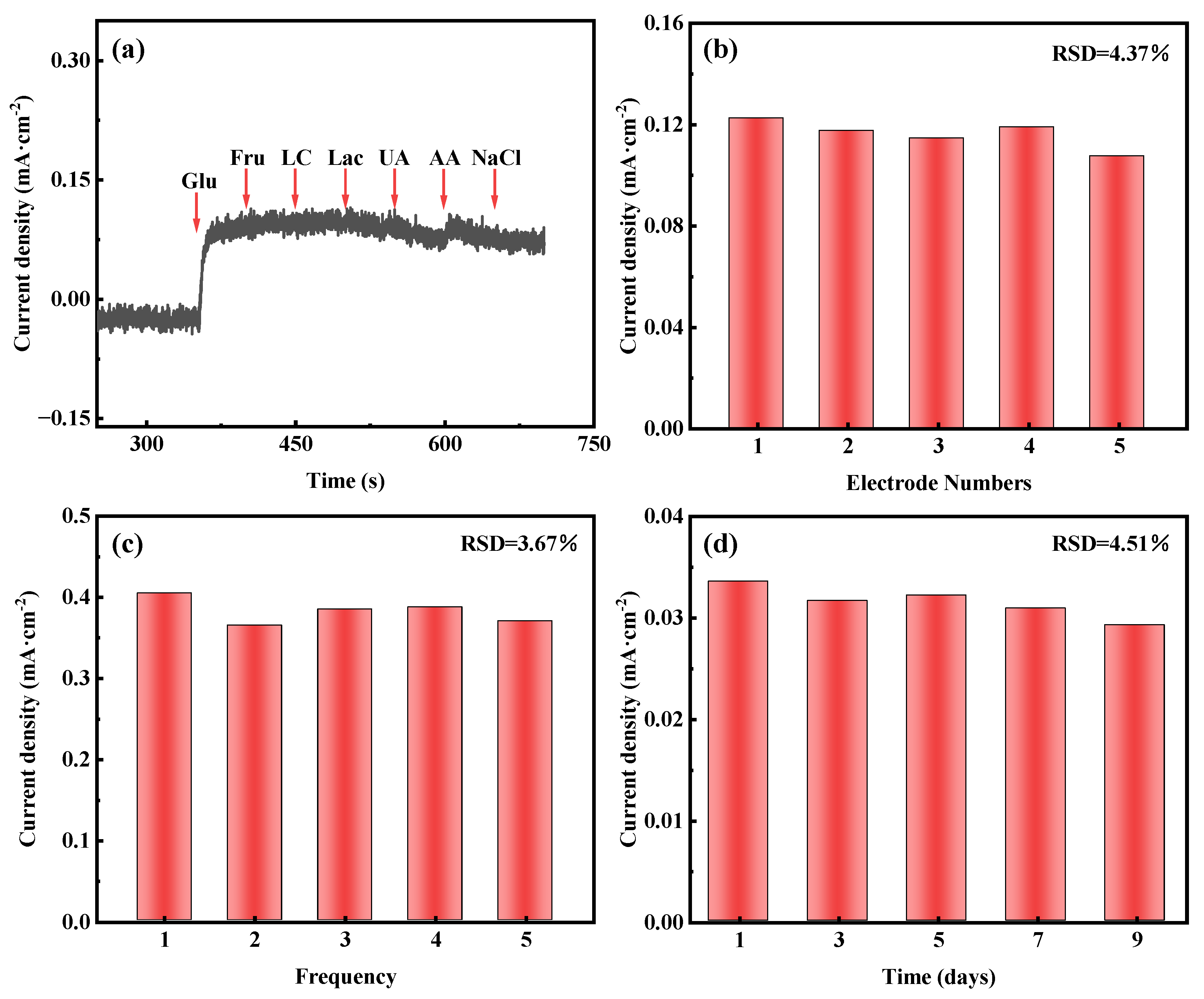
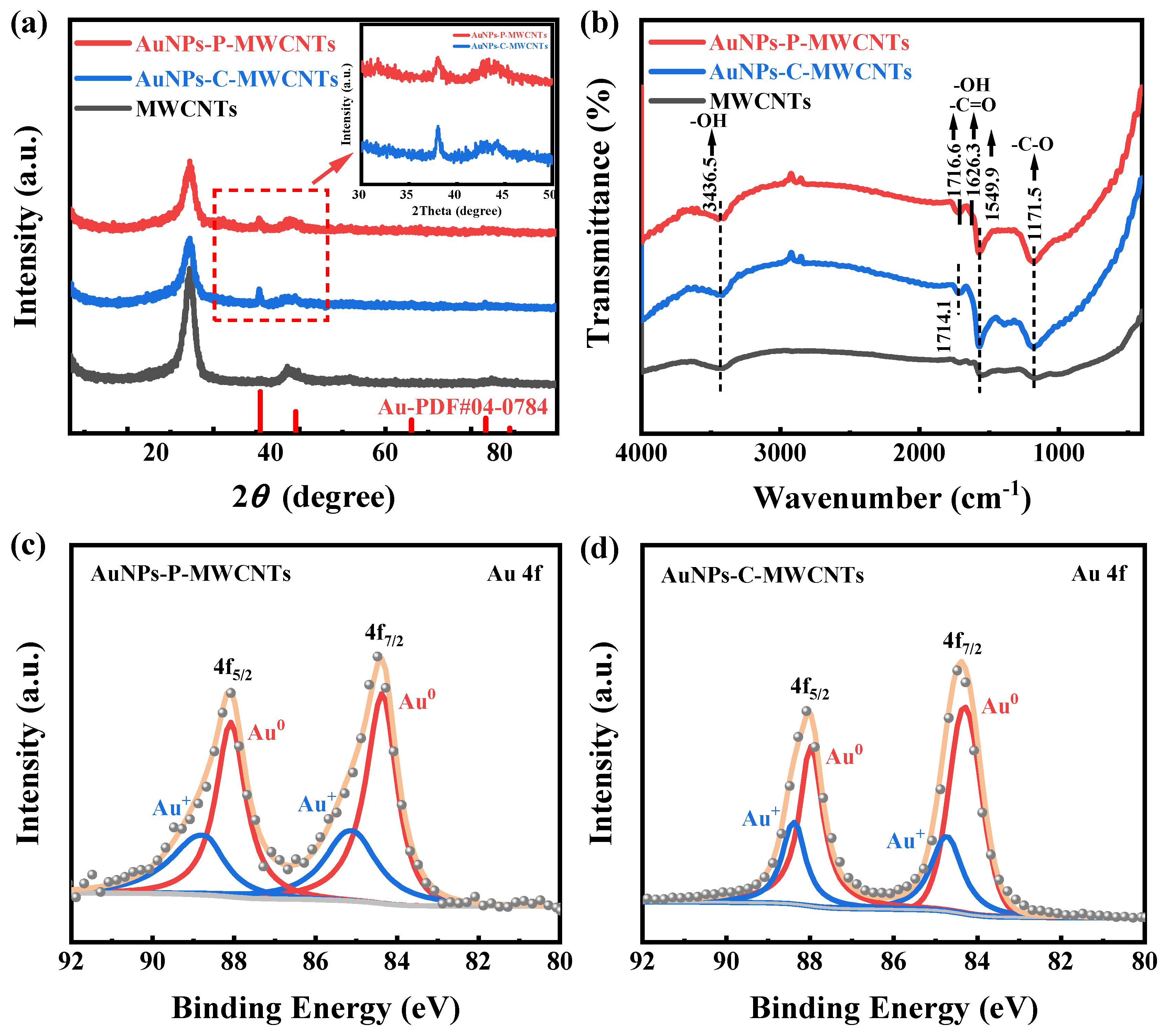
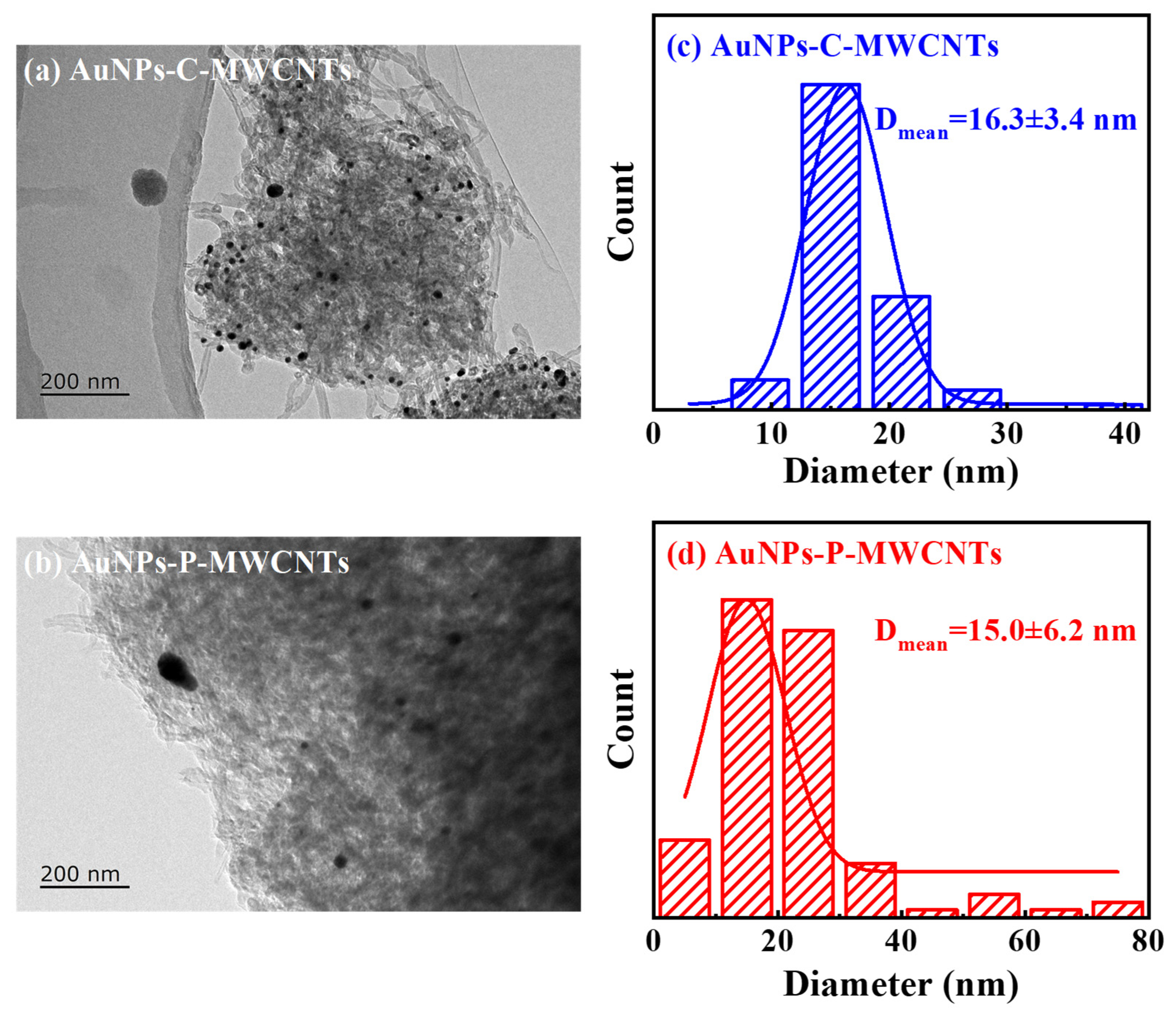
| Electrode Materials | Detection Limit (μM) | Sensitivity (μA·mM−1·cm−2) | Dynamic Range (mM) | Response Time | Supporting Electrolyte | References |
|---|---|---|---|---|---|---|
| AuNPs/GC | 50 | 87.5 | 0.1–25.0 | / | 0.1 M NaOH | [61] |
| Au NCs/GCE | 100 | 2131 | 1.0–9.0 | / | 0.1 M NaOH | [62] |
| Porous Au | 5 | 11.8 | 2.0–10.0 | 2 s | 0.1 M PBS + 0.1 M KCl | [63] |
| Au NPs/ITO | 5 | 23.0 | up to 11 | / | 0.5M KOH | [64] |
| AuNPs/PANI/CC | 3.08 | 150 | 0.0126–10.0 | / | 0.5M KOH | [65] |
| Pt-Au/MWCNT | 10 | 10.71 | 0.04–24.4 | / | 0.01 M PBS | [66] |
| Au-Gt | 66 | 19.4 | 1–14 | / | 0.3 KOH | [67] |
| Au-rGtO | 63 | 39.8 | 0–10 | / | ||
| Au-GtO | 99 | 98.7 | 0–25 | / | ||
| AuNPs/Ni(OH)2 NS | 0.66 | 82.71 | 0.002–6 | / | 0.1 M NaOH | [68] |
| Au-DS/GSE | 190 | 1904 | 0.05–5 | / | 0.1 M KOH | [69] |
| Au-Gr/GE | 12 | 604 | 0.05–42 | / | 0.1 M PBS | [70] |
| Au-graphene nanosheet | 50 | 326 | 0.1–16 | / | 0.1 M PBS | [71] |
| GCE-MWCNTs-MSA-AuNPs | 0.036 | 22.9 μA·cm−2 | 0.00012–0.004 | / | KOH | [23] |
| fn.MWCNT–Aunano modified SPE | 4.1 | 2.77 ± 0.14 μA·mM−1 | 0.1–25.0 | / | 0.1 M PBS | [20] |
| Nafion® modified fn.MWCNT–Aunano SPE | 10.0 | 0.55 ± 0.03 μA·mM−1 | 0.1–25.0 | / | 0.1 M PBS | [20] |
| AuNPs-C-MWCNTs | 170 | 23 | 0.2–21.71 | 3.8 s | 0.1 M KOH | This work |
| AuNPs-P-MWCNTs | 0.21 | 73 | 0.2–21.71 | 2.1 s | 0.1 M KOH | This work |
Disclaimer/Publisher’s Note: The statements, opinions and data contained in all publications are solely those of the individual author(s) and contributor(s) and not of MDPI and/or the editor(s). MDPI and/or the editor(s) disclaim responsibility for any injury to people or property resulting from any ideas, methods, instructions or products referred to in the content. |
© 2025 by the authors. Licensee MDPI, Basel, Switzerland. This article is an open access article distributed under the terms and conditions of the Creative Commons Attribution (CC BY) license (https://creativecommons.org/licenses/by/4.0/).
Share and Cite
Yang, Q.; Pang, Y.; Li, H.; Di, L. Rapid Plasma Synthesis of Gold Nanoparticles Supported on MWCNTs for Electrochemical Detection of Glucose. Materials 2025, 18, 3076. https://doi.org/10.3390/ma18133076
Yang Q, Pang Y, Li H, Di L. Rapid Plasma Synthesis of Gold Nanoparticles Supported on MWCNTs for Electrochemical Detection of Glucose. Materials. 2025; 18(13):3076. https://doi.org/10.3390/ma18133076
Chicago/Turabian StyleYang, Qing, Yuanwen Pang, Hong Li, and Lanbo Di. 2025. "Rapid Plasma Synthesis of Gold Nanoparticles Supported on MWCNTs for Electrochemical Detection of Glucose" Materials 18, no. 13: 3076. https://doi.org/10.3390/ma18133076
APA StyleYang, Q., Pang, Y., Li, H., & Di, L. (2025). Rapid Plasma Synthesis of Gold Nanoparticles Supported on MWCNTs for Electrochemical Detection of Glucose. Materials, 18(13), 3076. https://doi.org/10.3390/ma18133076






